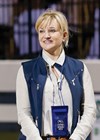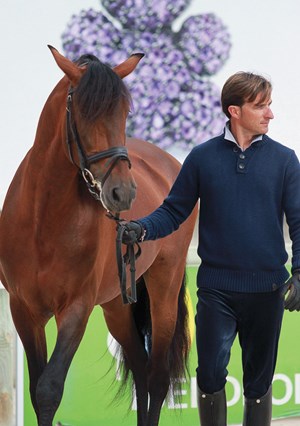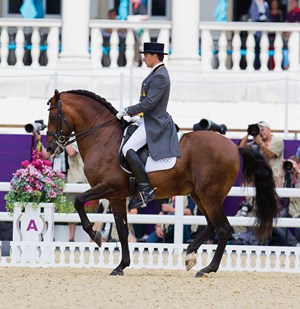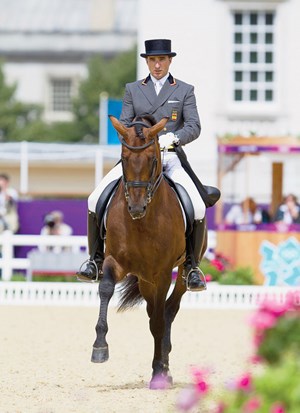
When Kim Boyer bought the PRE stallion Grandioso III (Adelante X/Sevillano IX) in 2002 at the Yeguada Marin Garcia in Spain, he was an unstarted 4-year-old. She had never owned an international Grand Prix horse, but she had high hopes. Their journey to the 2012 London Olympics took a strong belief in his talent by her and by his team through the years: Courtney King-Dye, Lendon Gray, Daniel Martin Dockx and Jan Bemelmans along with many others.

Boyer speaks Spanish and has helped develop the USPRE breed registry in the United States. She spent years studying Spanish bloodlines, learning the temperaments and movements of the various lines while developing a breeding program for dressage performance at her Hampton Green Farm, located in Fruitport, Michigan, and Wellington, Florida. She had purchased horses from the Sevillano IX line, which is strong with Albero II, known for producing extraordinary movement. And she has been chasing the lines that Grandioso III is blessed with.
Boyer says it was Martin Schaudt, German Olympic gold medalist, who first believed Grandioso III was as good as, if not better than, many European warmbloods. “He thought he was a youngster with great scope for his future toward the international stage,” remembers Boyer. Initially, she worked Grandioso III with a staff rider, but then began the journey to look for an American rider who could take the horse up the ladder. “The problem back then was finding someone who was going to take a Spanish horse seriously in America to train for the potential international arena,” she explains.
Spanish-bred horses were generally not viewed in the United States as contenders. Most of the top professionals only worked with European warmbloods. Boyer knew she had an uphill battle in searching for the best path to reach her ultimate dressage goal.
U.S. Olympian Robert Dover suggested Boyer contact fellow Olympians King-Dye and Gray, who had a special affection for “alternate” breeds. With King-Dye and Gray, Grandioso’s training developed through Intermediaire II. King-Dye rode him to fifth place at the 2009 national championships at Intermediaire I. “Grandioso was a horse I had a strong emotional connection to,” says King-Dye. “When he was first with me, he behaved perfectly well, but I felt he wasn’t giving me that extra effort, showing that extra desire to achieve. I felt that every time I took him from the cross ties, he just thought of me ambivalently as ‘that girl who rides me.’ I needed to develop a personal relationship with him. Every afternoon I’d hand-walk Grandioso, not just lovey-dovey to get him to enjoy me but to earn his respect because that’s what love is based on. Soon he began looking at me with interest on the cross ties. It changed his whole demeanor and I got the extra effort I was searching for. He is smart, sensitive, fun.”

The pair was on its way when tragedy struck. Only days before their first Grand Prix competition in 2010, King-Dye suffered a debilitating riding accident on another horse. For 10 months Boyer waited and hoped for her return. Eventually, King-Dye recommended that Boyer find a new rider for Grandioso so he could have a chance to continue his training. The Olympics were the following year.
Finding the right situation was a challenge. Boyer wanted a rider who had experience with the breed. Then she met Bemelmans, the coach of the international Spanish team. He inquired about Grandioso, and Boyer became open to the possibility of a Spanish rider. Bemelmans told her that Spain was the best place for Grandioso to succeed and suggested a number of riders. Boyer had known Martin Dockx, a long-time student of Arthur Kottas, for several years and trusted him to train and ride the horse with the utmost care. Boyer, Bemelmans and Martin Dockx met in Wellington to observe the horse and discuss problems and possible strategies to prepare him for international competition.
Grandioso III was not yet confirmed in his piaffe, passage and one-tempi flying changes. Boyer first sent her horse to Bemelmans’ training stable in Germany before going to Spain to begin working with Martin Dockx. During the first six months, Gray spent several weeks in Spain helping the pair.
Martin Dockx began to show the horse in the national Grand Prix arena in Spain in the summer of 2011 under the direction of Bemelmans. The pair completed 10 starts at national shows to gain more experience. That strategy paid off when Martin Dockx and Grandioso won the Spanish National Championships in October 2011.

Getting to London was not so easy. Following their national success, Grandioso and Martin Dockx were put on the developing list for Spain, however, they still needed international Grand Prix Olympic qualifying scores. This was the greenest pair on the list with many good pairs in front of them.
The first step was to see how they would do in the larger shows against the best warmbloods of Europe. They began by traveling to Salzberg, Austria, in December, where they surprised everyone by finishing fourth in the Grand Prix and the Kür. They went to Saumur the following May and then to Fritzens Schindlhof (where the pair took second in the Grand Prix) followed by the big urban show at Rotterdam. The final qualifier would be the CDIO Aachen in Germany, so the pressure was on.
The other Spanish team riders there were Carmen Naesgaard riding Ciowa, Ignacio Bravo riding Fogonero, and Beatriz Ferrer-Salat, riding both Faberge and Delgado. Martin Dockx and Grandioso III were hoping only for the reserve position to go to London and the Olympics. It was at Aachen where they had their best ride, scoring over 70 percent and placing 10th in the Grand Prix. The reserve spot was secured. After years of starts and stops and an almost fairy-tale first year at Grand Prix for both horse and rider, the dream of going to the Olympics was coming true.
Just prior to leaving for London, the call came from the Spanish federation that there was a possibility that Grandioso would move up to replace Delgado on the team. Boyer says it was a roller coaster of emotion during those days. The Spanish team needed Delgado and Ferrar-Salat if they wanted to have a chance for a medal. However, in the end, the decision was made to act in the best interest of the horse and keep Delgado at home. The reserve horse was called up. Grandioso was going to compete in London!
With the chances for a medal for Spain now dashed due to the withdrawal of Delgado, Grandioso’s job was to do well enough for the team to advance to the Grand Prix Special, which would allow the top horse, Fuego de Cardenas, to advance to the Kür. The pair’s solid Grand Prix test (69.027 percent) combined with scores from teammates Morgan Barbancon and Juan Manuel Munoz, placed Spain in the top seven teams and in the Special. There, Grandioso and Martin Dockx came through again, scoring 69.286 percent. In the final standing, Martin Dockx and Grandioso finished 29th out of the 50 top dressage competitors in the world, an overall outstanding success for a rookie rider and a green PRE horse with only seven months of international Grand Prix experience behind them. For the horse, his rider, owner and all the others involved in his story, it is nothing short of a dream come true.

No longer rookies, Martin Dockx and Grandioso III continued their rise in the international arena, winning both the Grand Prix and the Kür in each of the first three CDIs of 2013 in Spain. In both weeks of the Sunshine Tour as well as the CDI3* Toledo, the pair has achieved personal-best scores ranging from 70 to 75 percent. This year their sights are set for the European Championships and after that, who knows?
King-Dye continues to follow Grandioso’s success and says that Boyer keeps her involved. “She sent me to Spain to teach her new rider, and she sends me videos from the big shows and of him training his new freestyle.”
Boyer sums up her journey: “For years I’ve directed my equestrian interests into the promotion of the Spanish horse, always arguing that a well-bred, well-trained PRE could compete with the best warmbloods in the sport. There have been others prior to Grandioso that have already proven this—Evento, Invasor, Fuego and so on. And we have had many good PREs here in America that have achieved various levels of success. Going to London with Grandioso, however, was something that I could only dare to dream about, and I still find it hard to adequately express my memories of the experience. I am very grateful to all who invested in Grandioso, especially his riders and trainers. I know that this little brown stallion has already changed the definition of a dressage horse for many and this will open the doors for more Spanish equine athletes to rise to the top.”












